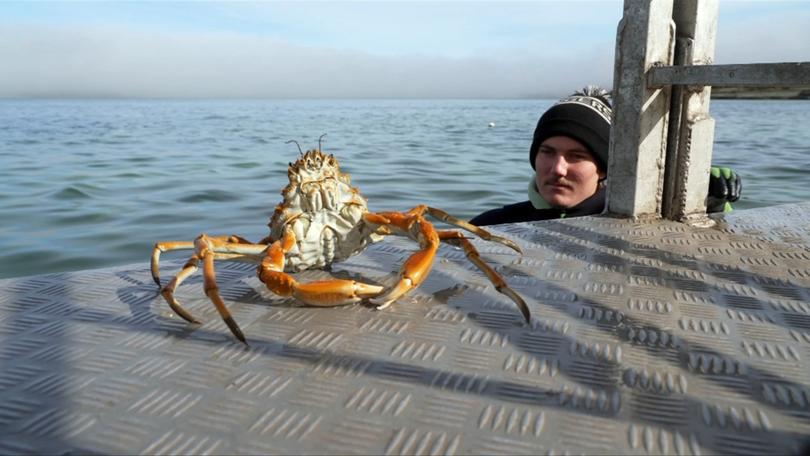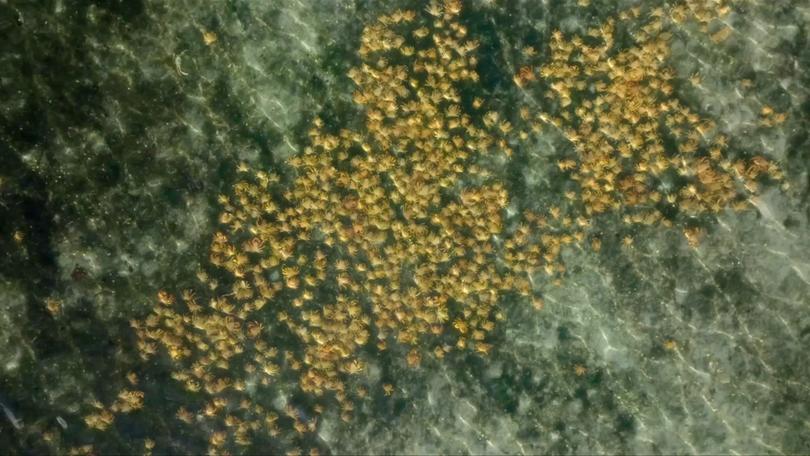‘Invasion’ of giant spider crabs baffles locals at South Australia’s Kellidie Bay
Tens of thousands of giant spider crabs have migrated to South Australia’s Eyre Peninsula, baffling locals and scientists alike.
Coffin Bay Oyster Farm’s Lester Marshall said he has never seen so many of the crabs gather at Kellidie Bay, 49km west of Port Lincoln.
He said it is likely the “invasion” of crabs marched up through the channels of Coffin Bay and came across to moult.
Sign up to The Nightly's newsletters.
Get the first look at the digital newspaper, curated daily stories and breaking headlines delivered to your inbox.
By continuing you agree to our Terms and Privacy Policy.“In the 25 to 35 years I’ve been oyster farming, I’ve never seen this many come here and we’re not sure why,” Marshall said.
“It is a sight to behold, that’s for sure.”

Giant spider crabs are found throughout the Great Southern Reef that stretches from the west to east coast of Australia.
They can measure up to 16cm across their shells and 70cm across their legs.
As they grow bigger, the crabs extract themselves from their shells in a process known as moulting.
It is believed giant spider crabs gather in large numbers to protect themselves from predators when they are at their most vulnerable without their shells.
Deakin University researchers have been trying to understand more about the crabs by asking members of the public to document sightings through a citizen science project.
Marine ecologist Dr Elodie Camprasse has been leading the work and said it is still not known where the crabs are coming from to gather in mass numbers.
“We know very little about spider crabs,” Camprasse said.
“I can’t tell you if it’s unusual or whether it’s just not been reported … but either way it’s pretty exciting that it’s getting reported now,” she said about the Kellidie Bay sighting.

When she started her research more than two years ago, Camprasse said the only scientific information on the crab gatherings was in Victoria’s Port Phillip Bay and in Tasmania.
“As a result of me doing media interviews, people have contacted me saying, ‘Why don’t you ever say we have spider crabs in South Australia too?’ and it’s (because) I didn’t know, it’s not reported anywhere,” she said.
Camprasse said her team has set up underwater cameras in Port Phillip Bay to determine where the crabs are coming from to moult in one location.
“In Port Philip Bay, the big question is: do they live in the bay?” she said.
“We think they live solitary lives at other times, perhaps in deeper water, then come together to moult or they would be coming from Bass Strait.
“(But) this just hasn’t been scientifically investigated.”
Camprasse has been told of giant spider crab sightings in Kangaroo Island and in the Spencer Gulf, but said there is not much consistent or detailed information.
She said scientists also do not know how or why the crabs travel long distances, or what triggers them to moult at the same time.
“Some people think it’s the full moon, some people think it has to do with water temperature, so that’s what we’re investigating at the moment,” Camprasse said.
She said giant spider crab mass gathering were unique to Australia, and it was important for local communities to understand more about their marine life.
“It does generate tourism and interest from people from interstate and overseas,” Camprasse said.
Originally published on 7NEWS
